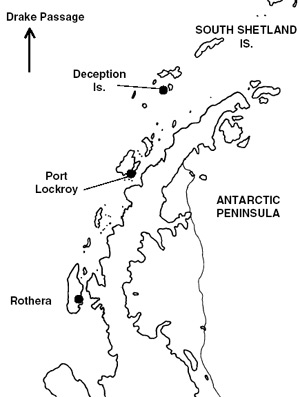
| Glasgow Digital Library | Voyage of the Scotia | BRUCE | PEOPLE | SHIP | ANTARCTIC | INDEX |
|---|
The Antarctic continent has been fortunate not to have been subjected to war. The two countries which are closest to the continent are Chile and Argentina, and these only gained their independence from Spain in the 19th century. Minor border disputes have been a problem in the past and there has always been a little antagonism between the two countries.
During this war there were two battles between German and British fleets. The first encounter was off the coast of Chile (38°S). Two British ships were sunk and two escaped at the Battle of Coronel. The German fleet then sailed around Cape Horn to return home through the Atlantic. They decided to attack the Falkland Islands on the way.
A fleet of British warships were refuelling in Stanley Harbour in the Falkland Islands when news came of the approaching German fleet. The superior British force sailed out to meet the Germans and the Battle of the Falklands followed when five large units of the German fleet were sunk and two escaped (only to be sunk at a later date).
The Battle of the Atlantic during the second world war was the fight against the U-boats which were stopping essential supplies from reaching the United Kingdom. Long-distance submarines went to the South Atlantic and a large number of ships were sunk off South Africa and north-eastern Brazil. Some of these sailed south into Antarctic waters to meet with their supply ships. No ships were sunk by submarines in Antarctic waters (south of the Antarctic Circle).

The second worry to the British were the German raiders which were loose in the Atlantic. Most famous was the German pocket battleship Graf Spee. She sank the refrigerated cargo boat Doric Star carrying meat from Argentina off the African coast (where she was to join a convoy off South Africa). Graf Spee then proceeded towards Buenos Aires where she hoped to encounter more 'meat boats'. Graf Spee encountered a British fleet which resulted in the Battle of the River Plate. Severely damaged by the British, she went into Montevideo for repairs. Fearing a large British fleet outside the harbour she went out and was scuttled by the crew.
In 1941, Britain blew up the fuel dumps on Deception Island as they feared they might be used to refuel submarines. Three Norwegian whalers had been sunk off Kerguelen Island by submarines. In 1943, the British government set up Operation Tabarin which resulted in two bases being set up in the Antarctic at Deception Island and at Port Lockroy. These bases were intended to keep an eye on shipping movements in the area of the Drake Passage and to produce meteorological information.
After the war, Operation Tabarin became the Falklands Islands Dependencies Survey (FIDS) which covered the Falkland Islands, South Georgia, the South Orkney and South Shetland Islands and the Antarctic Peninsula. Seven stations were established in the Antarctic.
The dispute over the territory in the Antarctic between Britain, Argentina and Chile continued after the war. In 1947 Argentine and Chile refused to take their case to the International Court of Justice in the Hague. In 1948 a Norwegian boat was stopped and told it was in Argentinian waters. In 1952, Argentinian military personnel opened fire on a British party landing supplies at Hope Bay on the Antarctic Peninsula (the first and only case of a military attack on the continent).
In 1976 an Argentinian destroyer opened fire on the British research ship RRS Shackleton which was told to leave Argentinian waters. In the same year the Argentinians set up a scientific base on South Thule in the South Sandwich Islands.
| Glasgow Digital Library | Voyage of the Scotia | BRUCE | PEOPLE | SHIP | ANTARCTIC | INDEX |
|---|